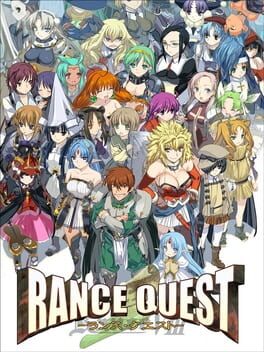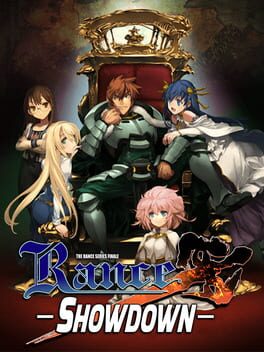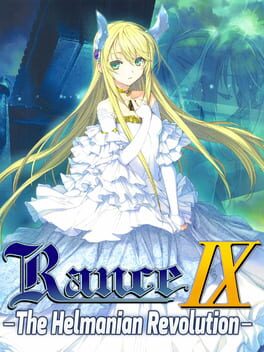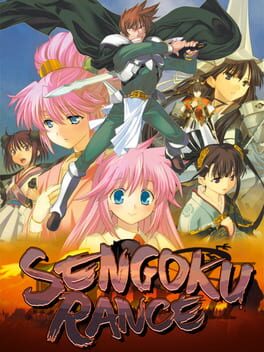

Rance Quest is the 11th game in the Rance Series. Unlike its predecessor, Rance Quest is not a strategy conquest game - instead, it is a role-playing game similar to Rance VI, but tweaked to include features from Sengoku Rance and Toushin Toshi 3. It includes 3D graphics for both dungeon exploration and enemy display in battle, using a first person view battle system.
Also in series
Reviews View More
Finished Rance Quest. Honestly, in terms of gameplay, it's lackluster, and the post-game content doesn't match up to the sixth installment (or maybe because I cleared all the side content before finishing the game).
I'll list the points as I'm feeling a bit lazy to write neatly:
+ Rance Quest features a plethora of characters from the entire Rance series.
+ It's a significant series for me due to the lore development, particularly the insights into the nature of the Rance world and the introduction of the character Crook (though already explored in Kichikuou Rance, this is the canon version).
+ Rance is portrayed in a more humane light here, especially with his adorable daughter, Reset. The wholesome moments whenever she appears are delightful.
+ While the artwork might not be as stunning as Sengoku, it's still one of the best eroge in terms of visual CGs and character designs that I've come across.
= The castle events (yes, Rance has a castle here) that you can access after completing quests (and later there's a moment where you don't need to quest anymore), along with the random events in the town with a slice-of-life vibe post-quest, featuring random characters. Initially enjoyable as we get to interact with our party, but with dozens, even hundreds of characters, clicking through their events gets tiresome when you just want to finish quickly.
= The gameplay is basic, similar to the sixth installment, a dungeon crawler with skill points, but viewed from the top rather than the RPG-style ala Might and Magic in the sixth series. It's a matter of taste; personally, I'm not a fan.
- The quests are of the "take whatever you want as long as the main requirement is met" type. Most of them are comedic, but the main story events are quite linear, which I consider a step backward from Sengoku Rance.
- There are hundreds of quests with unclear quality. Sometimes they deliver humorously, sometimes they're just random and silly.
- There's a lack of new memorable characters. Sachiko, the new sidekick, is meant to replace Sill, but in my opinion, she doesn't quite fill the gap.
- There's no grand-scale plot that truly stands out here; the conflicts feel small compared to what we experienced in the sixth and seventh installments. Even though there are two significant plots intertwined (Rance Quest and the Magnum main story), the conflicts still feel minor.
- I found the antagonists to be underwhelming, with minimal presence throughout the story. Their characterization and plot execution when their actions are revealed also felt lacking.
- Half of the game lacks any impactful moments, the Kalar story arc (Rance Quest main story) follows the typical comedic random storyline of Rance, and the story only becomes engaging during the Magnum main story conflict, but that's only in the final sessions of the game. Imagine playing a 60-hour game just to experience a good plot in the last 10 hours.
- Grinding in this game... exhausting. There are places to farm, but are you really going to farm XP when there are dozens of characters here? And sometimes it's necessary because the gameplay is typical old-school RPG where your attacks depend on spent skill points. Eventually, there comes a time when you have to swap characters (which has a limit depending on your charisma points accumulated through completing quests). Oh, and they have a level cap, and Rance has to sleep with them, and their level cap increases, but then you have to grind again because their level drops to 0 again (and then it was updated to drop 4-5 levels after sleeping together once). Most of this game can be considered grinding, something I despise in JRPGs. If it weren't for the Rance brand, I would have dropped this game.
- There's a lack of things to discover, and sometimes random requirements are needed to trigger events/characters (like having to bring specific characters that you wouldn't know unless you consulted a guide).
- The environments are typical of low-budget RPGs, with assets being reused to the fullest extent.
Overall, this game favors quantity over quality, with hundreds of shallow quests and characters who only have 1-2 events before becoming irrelevant. It's linear and a significant decline from Sengoku Rance, which excelled in gameplay loop, discoverability, replay value, and grand storylines in the sixth and Sengoku series. If it weren't for Rance and Reset, this game wouldn't have been salvaged.
My rating: 6/10.
I'll list the points as I'm feeling a bit lazy to write neatly:
+ Rance Quest features a plethora of characters from the entire Rance series.
+ It's a significant series for me due to the lore development, particularly the insights into the nature of the Rance world and the introduction of the character Crook (though already explored in Kichikuou Rance, this is the canon version).
+ Rance is portrayed in a more humane light here, especially with his adorable daughter, Reset. The wholesome moments whenever she appears are delightful.
+ While the artwork might not be as stunning as Sengoku, it's still one of the best eroge in terms of visual CGs and character designs that I've come across.
= The castle events (yes, Rance has a castle here) that you can access after completing quests (and later there's a moment where you don't need to quest anymore), along with the random events in the town with a slice-of-life vibe post-quest, featuring random characters. Initially enjoyable as we get to interact with our party, but with dozens, even hundreds of characters, clicking through their events gets tiresome when you just want to finish quickly.
= The gameplay is basic, similar to the sixth installment, a dungeon crawler with skill points, but viewed from the top rather than the RPG-style ala Might and Magic in the sixth series. It's a matter of taste; personally, I'm not a fan.
- The quests are of the "take whatever you want as long as the main requirement is met" type. Most of them are comedic, but the main story events are quite linear, which I consider a step backward from Sengoku Rance.
- There are hundreds of quests with unclear quality. Sometimes they deliver humorously, sometimes they're just random and silly.
- There's a lack of new memorable characters. Sachiko, the new sidekick, is meant to replace Sill, but in my opinion, she doesn't quite fill the gap.
- There's no grand-scale plot that truly stands out here; the conflicts feel small compared to what we experienced in the sixth and seventh installments. Even though there are two significant plots intertwined (Rance Quest and the Magnum main story), the conflicts still feel minor.
- I found the antagonists to be underwhelming, with minimal presence throughout the story. Their characterization and plot execution when their actions are revealed also felt lacking.
- Half of the game lacks any impactful moments, the Kalar story arc (Rance Quest main story) follows the typical comedic random storyline of Rance, and the story only becomes engaging during the Magnum main story conflict, but that's only in the final sessions of the game. Imagine playing a 60-hour game just to experience a good plot in the last 10 hours.
- Grinding in this game... exhausting. There are places to farm, but are you really going to farm XP when there are dozens of characters here? And sometimes it's necessary because the gameplay is typical old-school RPG where your attacks depend on spent skill points. Eventually, there comes a time when you have to swap characters (which has a limit depending on your charisma points accumulated through completing quests). Oh, and they have a level cap, and Rance has to sleep with them, and their level cap increases, but then you have to grind again because their level drops to 0 again (and then it was updated to drop 4-5 levels after sleeping together once). Most of this game can be considered grinding, something I despise in JRPGs. If it weren't for the Rance brand, I would have dropped this game.
- There's a lack of things to discover, and sometimes random requirements are needed to trigger events/characters (like having to bring specific characters that you wouldn't know unless you consulted a guide).
- The environments are typical of low-budget RPGs, with assets being reused to the fullest extent.
Overall, this game favors quantity over quality, with hundreds of shallow quests and characters who only have 1-2 events before becoming irrelevant. It's linear and a significant decline from Sengoku Rance, which excelled in gameplay loop, discoverability, replay value, and grand storylines in the sixth and Sengoku series. If it weren't for Rance and Reset, this game wouldn't have been salvaged.
My rating: 6/10.
Rance Quest is a genuinely fantastic RPG. per-hour it's definitely the least plot-heavy game in the franchise but it easily makes up for it with side-content that basically bumps what feels like a 20 hour game to 45 hours (side content that is gameplay-wise intrinsically tied to progression).
the general gist of what makes Rance Quest tick is that progression is gated to Level 35 and then a reset brings characters back to Level 1 with slightly buffed stats and an increased level cap (with fast-tracked exp gain until they get back to 35). While the end-game (of base Quest) skill resets are frustrating due to the game's fuckn 50+ party members, it's this weird actionable goal that makes it feel like character growth is this consistent 'alive' thing with constant skill respecs that allow you to approach character builds slightly differently every Mororun run. its so fuckn weird; its such a unique approach to character progression.
With a realistic end-game party roster of probably ~30 characters, the approach to party makeup ends up being this hap-dash philosophy of trying to cover weaknesses and gaps in your roster while trying to juggle mid-quest deaths. Your quest-start party will never end up your quest-end party as characters will frequently get one-shot, characters run out of moves, characters hit level cap, etc.
even though i think it's a great RPG its the definitely the odd one out in modern Rance alongside the weird Rance 5D having nothing to do with political intrigue/military reunification (fancy words for rape and pillage). iunno. definitely the worst aspect of Quest. Needed a bit more political schlock.
the general gist of what makes Rance Quest tick is that progression is gated to Level 35 and then a reset brings characters back to Level 1 with slightly buffed stats and an increased level cap (with fast-tracked exp gain until they get back to 35). While the end-game (of base Quest) skill resets are frustrating due to the game's fuckn 50+ party members, it's this weird actionable goal that makes it feel like character growth is this consistent 'alive' thing with constant skill respecs that allow you to approach character builds slightly differently every Mororun run. its so fuckn weird; its such a unique approach to character progression.
With a realistic end-game party roster of probably ~30 characters, the approach to party makeup ends up being this hap-dash philosophy of trying to cover weaknesses and gaps in your roster while trying to juggle mid-quest deaths. Your quest-start party will never end up your quest-end party as characters will frequently get one-shot, characters run out of moves, characters hit level cap, etc.
even though i think it's a great RPG its the definitely the odd one out in modern Rance alongside the weird Rance 5D having nothing to do with political intrigue/military reunification (fancy words for rape and pillage). iunno. definitely the worst aspect of Quest. Needed a bit more political schlock.
This review contains spoilers
Rance Quest, despite being perhaps the most straightforward RPG in the Rance series, is a bit of an oddball, in that it doesn't really have one main plot tying everything together like the rest of the games in the series do. Sure, it does have an overarching story with major antagonists and two different endings, but it mostly takes a backseat as the player is treated to a look into Rance's daily life. (And also how he copes without Sill, his slave/morality pet by his side.)
The story reads like a slice-of-life manga, and I mean that in an endearing way. Some nice, lighthearted antics may be just what a player needs after the back-to-back gut punches that were Rance VI and Sengoku Rance. Quest does have some dark moments of its own, but overall it's not nearly as much to deal with as the previous two games.
This is perhaps the most we see of Rance not just as an adventurer, but as a person. We see him running errands. We see him hanging out and even going on dates with the various woman he's wooed over the past seven games. We see him in his off-time. And also, with the birth of his second child, we see more of him being a dad.
In terms of overall story progression, it isn't a huge step other than the introduction of some important recurring characters, but it is a charming and much appreciated analysis of Rance's psyche... and also a last hurrah before Rance IX and X, the last two games in the series, in which the sexy stuff gets put on the back burner to properly conclude the saga. Quest knew this would happen, and so Quest goes all out with said sexy stuff.
In this game, Rance is cursed to be unable to have sex with most women, and while to him it's a huge mental burden, to the player it's a treat, because we get to see him come up with really creative ways to get around the restrictions of the curse, leading to a much greater variety in the H-scenes than any previous game in the series. If there is any Rance game to play for the porn, it may very well be Quest.
The gameplay however, while serviceable, is a bit bland, especially coming off of Sengoku Rance, a strategy game that rivals even non-H games in terms of depth. It isn't too difficult to break the game with Cheat Engine if you just want to read the story, though.
Bottom line: Rance Quest is a bit of a breather episode in the Rance series, but man is it a good read.
The story reads like a slice-of-life manga, and I mean that in an endearing way. Some nice, lighthearted antics may be just what a player needs after the back-to-back gut punches that were Rance VI and Sengoku Rance. Quest does have some dark moments of its own, but overall it's not nearly as much to deal with as the previous two games.
This is perhaps the most we see of Rance not just as an adventurer, but as a person. We see him running errands. We see him hanging out and even going on dates with the various woman he's wooed over the past seven games. We see him in his off-time. And also, with the birth of his second child, we see more of him being a dad.
In terms of overall story progression, it isn't a huge step other than the introduction of some important recurring characters, but it is a charming and much appreciated analysis of Rance's psyche... and also a last hurrah before Rance IX and X, the last two games in the series, in which the sexy stuff gets put on the back burner to properly conclude the saga. Quest knew this would happen, and so Quest goes all out with said sexy stuff.
In this game, Rance is cursed to be unable to have sex with most women, and while to him it's a huge mental burden, to the player it's a treat, because we get to see him come up with really creative ways to get around the restrictions of the curse, leading to a much greater variety in the H-scenes than any previous game in the series. If there is any Rance game to play for the porn, it may very well be Quest.
The gameplay however, while serviceable, is a bit bland, especially coming off of Sengoku Rance, a strategy game that rivals even non-H games in terms of depth. It isn't too difficult to break the game with Cheat Engine if you just want to read the story, though.
Bottom line: Rance Quest is a bit of a breather episode in the Rance series, but man is it a good read.





